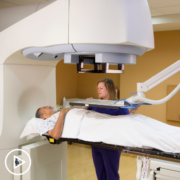Prostate Cancer Staging: What Patients Should Know
Prostate Cancer Staging: What Patients Should Know from Patient Empowerment Network on Vimeo.
Dr. Sumit Subudhi provides a brief explanation of the stages of prostate cancer, the role of staging in determining a prostate cancer patient’s treatment path, and how patients can advocate for a precise diagnosis.
Dr. Sumit Subudhi is a Medical Oncologist at The University of Texas MD Anderson Cancer Center.
See More From INSIST! Prostate Cancer
Related Resources

Prostate Cancer Testing: What Tests Should You Advocate For? |

|

How Can You Access Personalized Prostate Cancer Treatment? Resource Guide |
Transcript:
Katherine:
Well, Dr. Subudhi, I’d like you to begin with a brief explanation of the stages of prostate cancer.
Dr. Subudhi:
We use stages, and there’s four – Stage I, II, III, and IV. And we use it to help us determine what treatments the patients need for their prostate cancer. In general, Stage I is localized prostate cancer, and it’s localized only to the prostate. And when we do a digital rectal exam, we cannot feel or palpate the prostate.
And the treatment for Stage I prostate cancer is either active surveillance, where you’re not trying to cure the cancer, you’re just actively watching it, and you’re using a PSA imaging studies, prostate biopsies, and digital rectal exams at regular intervals to follow the patients. But other patients with Stage I prostate cancer can actually get definitive treatment for curative intent with radiation therapy or surgery. Stage 2 prostate cancer is also localized, but on physical exam, we can actually palpate or feel the prostate cancer. And this also can receive definitive treatment for the prostate to cure it, and that, also, you can use radiation therapy and surgery.
Stage III is what I consider locally advance. This is where the prostate cancer is now starting to leave the prostate. And it still can be cured by radiation and surgery, but most likely needs a multidisciplinary approach, where you might need both or maybe even in addition of a systemic therapy. Stage IV is the last stage that I’ll talk about, and it has distant metastases. And here we’re not looking for a curative approach; we’re actually looking for palliation, which means that we’re trying to treat the prostate cancer as a chronic disease.
Katherine:
I understand that there are many types of prostate cancer that have been identified. How can patients advocate for a precise diagnosis?
Dr. Subudhi:
Yes, you’re absolutely right. There are many types. So, we have historically used histological classification. And when I say histological, that means when we look at the cancer under the microscope, we can look at the different structures within the prostate cancer and classify them.
And there are multiple types such as adenocarcinoma, neuroendocrine, small-cell, mucinous, etc. But more recently, with the advances in genetic and molecular testing, we now can look at the genes inside the prostate cancer, and that has also helped us better classify the cancer. Now many of these types of approaches are best done at major cancer centers, where they have experienced pathologists who actually evaluate both histologically and molecularly the cancer.
So, I recommend to my patients, or family and friends, that have been diagnosed with prostate cancer that they don’t necessarily have to go to the major cancer centers. They can have their local doctor send the tissue from the biopsy to the advanced cancer centers to get a second opinion.










